Avoiding delusions of strategy
What is a strategy? How do we create a strategy? – rather than merely a delusion of ‘strategy’?
Several of the folks in my Twitterstream – Gerold Kathan and Shawn Callahan, amongst others – pointed recently to a great HBR post by Roger Martin, ‘The Big Lie of Strategic Planning‘. (Fortunately – and, these days, unusually – the article seems to be available outside of HBR’s bewretched registration-wall.) Read that article first, then come back here.
The first point here is that strategy is about working with inherent uncertainties.By contrast, planning inherently starts off with a stream of assumptions around a general theme that the future can be made certain – of which, usually, the first of those assumptions is that the future will be just like the past, only more so.
We can use the SCAN frame to summarise where things can easily go wrong in strategy-development:
In one sense, strategy and planning have some similarities, in that both take place at some distance away in time from the point of action: in SCAN terms, both are some way up from the base of the frame, though with strategy usually ‘higher’ (further from ‘now’) than planning. Yet strategy and planning are also very different: key parts of strategy will, by definition, be way over on the far-right of the frame, whereas most of planning focusses on the supposed ‘certainties’ of the far-left – or aim to get there, at any rate. If we mix these up in any way – treating strategy as as if it’s as ‘certain’ as planning, or planning as ‘uncertain’ as strategy, or either as the same as the ‘now’ of operations – then we’re going to be in trouble: big trouble…
The next point – as Roger Martin makes clear in his article – strategy is more about feeling than thinking. It’s also much more about people than about plans. We can use the Five Element model to highlight those distinctions:
No-one doubts that serious thinking is required, in business and elsewhere, if plans are going to come to fruition. But that kind of thinking comes later in the Five Element cycle – and between the ‘feeling’-orientation of the Purpose phase, and the ‘thinking’-orientation of the Preparation or planning phase, that strategy has to pass through the gauntlet of the ‘storming’ that takes place in the People phase. That ‘storming’ phase – and indeed the exploration that comes before it – can often be very uncomfortable indeed, as Roger Martin warns in his article; but if we try to skip over that phase, the strategy will fail. There’s no viable way to avoid it: the only kind of comfortable, certain ‘strategy’ we can think our way into will be a delusion, based on circular-reasoning and the rest. Not a good idea…
The Five Elements model also warns us of another trap that can arise from mistaking ‘think’ for ‘feel’: the ‘quick-profit failure-cycle’:
Roger Martin does also warn about this trap, if in a rather different way, citing the short-termist pressures of the share-market, and managers’ natural aversion to discomfort and their propensity towards ‘control’. Either way, the tendency to over-focus on ‘thinking’, and on the supposed ‘certainties’ over on the left-side of the SCAN frame lead straight to a short-cut loop that slowly stifles trust, purpose, values, relationships with people, and even the policies that underpin the thinking itself – and, eventually, yet seemingly ‘without warning’, into a death-spiral from which recovery is unlikely at best. In other words, yet another ‘Not a good idea…’.
The next theme Roger Martin highlights in his article is that much of the context of strategy is inherently beyond the organisation’s control. In SCAN terms, ‘control’ is possible only on the far-left of the frame, and only where the organisation’s assumptions and fiat can hold – which, in practice, will only occur within the organisation itself. As Martin says, that proviso definitely does not apply to an organisation’s customers, even in context of a business-monopoly. Yet it also does not apply with outsourced services, which are ‘inside’ the organisation’s boundary of identity , but ‘outside’ of its boundary-of-control’:
An outsourcing-contract may specify deliverables that match up with the expectations of planning; but if the outsourced behaviours – beyond the organisation’s control – fail to match up to those required by the feel of the strategy, then it’s the organisation that will wear most of the damage.
There are all manner of critical issues here that need to be addressed: the nature of enterprise as a shared-story, for example, or the necessary linkage between vision, role, mission and goal. If the so-called ‘strategy’ is merely a glorified form of planning, most of those ‘beyond-control’ issues are likely to be missed.
Finally, Roger Martin alludes to the very real need, in strategy-development, to avoid an over-focus on money – a dangerous tendency in business anyway, but one that is easily exacerbated whenever planning is confused with strategy. The reality is that, in all cases, much more than just money is involved – as indicated by the value-flows in the Enterprise Canvas model:
Money comes into the picture almost only at the end of the Five Elements cycle, in the ‘Completions’ transition between Process and Performance: it’s an outcome of successful service-delivery, and – given all of the preceding inherent-uncertainties of very little use or meaning much before that. Attempting to use predictions about money as a guide for tactics – let alone as a guide for strategy – all but guarantees a suicidal dive into the short-cut short-termism of the quick-profit failure-cycle.
Strategy is, by definition, a form of futures-work, so we can also illustrate the same point in another annotation on the Five Elements cycle:
Which also illustrates why ‘performance’-oriented managers are well-placed to extract money for themselves from that point in the cycle, whereas strategists rather obviously aren’t…
Anyway, let’s summarise all of this with a quick set of checklists, drawn in part from Roger Martin’s article, but also from the deeper detail of the models referenced above:
— Warning-signs of risk of a delusional pseudo-strategy:
- Sense of predictable certainty about all aspects of the future as described by the strategy – or, conversely, absence of discomfort or uncertainty about the future
- Extension of the past directly into the future – such as the classic “Our strategy is last year +10%”
- Description of the strategy primarily or solely in quantitative form – in particular, a description primarily or solely in monetary form, with projected profit as a kind of ‘reverse budget’
- Use of expectation of monetary-return as a (or the) primary input to strategy – rather than as a description of desired output
- Expectations of ‘control’ or ‘possession’ of arbitrary themes within the market, or ‘market-share’
— Cross-checks for a viable strategy:
- Clear sense of meaningful story that links across all of the shared enterprise (ideally expressed as a single phrase or sentence)
- Clear sense of the organisation’s place and role within that story
- Clear sense of the organisation’s qualitative promise and commitments to other actors within that role and story – including a clear sense of how the organisation will ensure that it keeps to those commitments
- Clear sense of the organisation’s relationships with all other actors in the shared-enterprise, as indicated by the strategy – and of the balances and cross-checks between each of those relationships
— Cross-checks for an actionable strategy:
- Clear description of how the strategic-story (Purpose) would connect with the enterprise-actors (People), then lead to appropriate tactics (Preparation), operations (Process) and identifiable outcomes (Performance), and thence link back both to the initial strategy and to inform future strategy
- Clarity on how the strategy would impact on relations with enterprise-actors
- Clarity on how existing and/or new capabilities would be used and/or required, to action the strategy
- Clarity on principles and values that could be used to support appropriate decision-making, in line with the ‘promise’ of the strategy, in any contexts of uncertainty at the point-of-action
- Clarity on what would or would not be considered a ‘good’ outcome in terms of the strategy, and how to identify such outcomes
- Clarity on how the strategy supports revision of itself – i.e. ‘emergent strategy‘ – in line with the overall enterprise-story, of which the strategy is itself just one possible expression
Enough for now, but I hope that provides a useful addendum to Roger Martin’s article?
Comments, anyone?
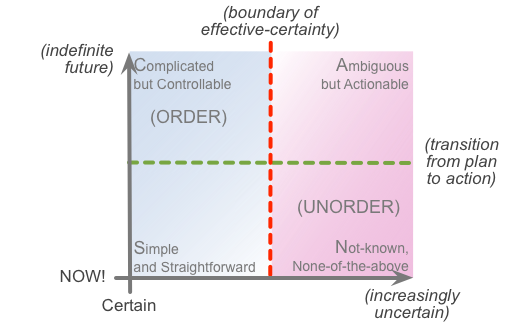
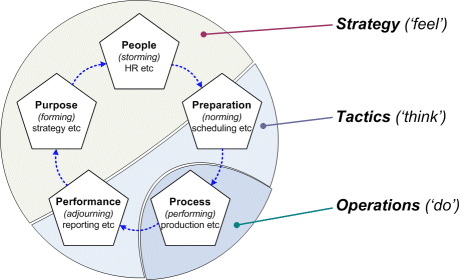

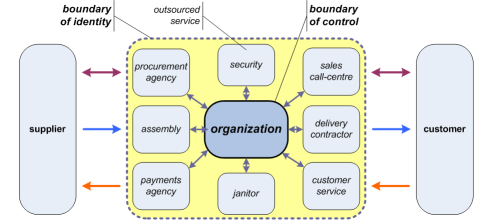
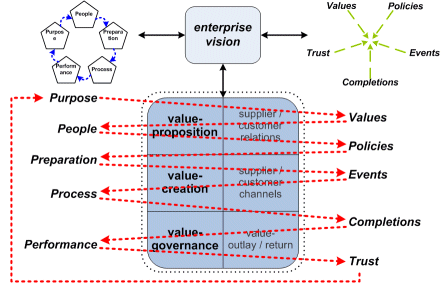
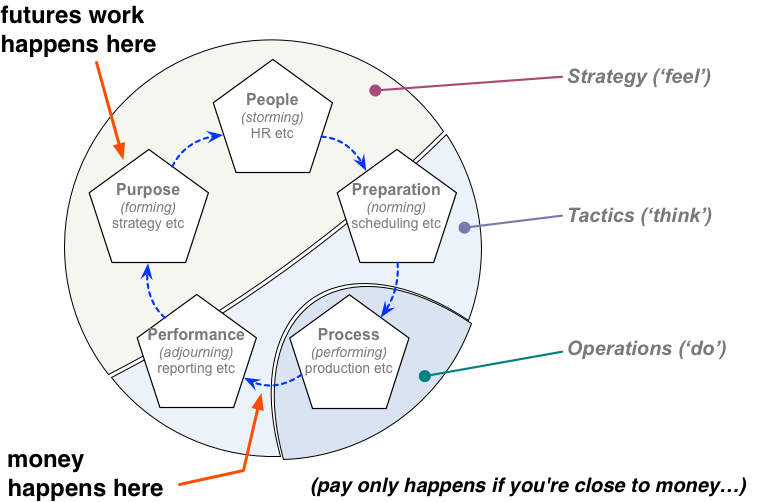
Thanks Tom. This is a nice deeper dive into the material in Roger Martin’s post (thanks for pointing me at that, by the way) and helps to show how we can do something concrete with those insights.
I need to read it a couple more times before I can comment beyond that. What I did want to say is that I think it’s worth relating this to Jack Martin Leith’s “new now” idea.
Jack made the point that, in any kind of transformation programme, whatever you do first is not just a step along a road but will be the new reality for the enterprise – the new now. I expanded on this idea myself in a couple of blogs for The Open Group earlier this year. Here’s a link to the first of these: http://blog.opengroup.org/2013/01/10/the-death-of-planning/ (the second one appears in the archives under February.
I argued that this way of looking at things was essential partially because of the inherent uncertainty in long term strategy (which you discuss so elegantly above) but also partly because the perceptions of what needs to change will themselves be changed by whatever reality the new now presents to us. That’s not an argument for not planning anything, simply for restricting the plans to the near term, less uncertain future – not making “hard plans for fuzzy objectives”.
Of course what I missed was the danger pointed out by Martin and by you that strategy gets confused with planning. I suppose that is indeed the logical consequence of being scared of uncertainty. I also lacked the theoretical framework to attach it to. You’ve provided that.
I feel all these ideas can be pulled together. So I’ll read the whole post again and come back with some more comments.
Very good point about Jack’s ‘the new now’ concept, Stuart, and yes, will look forward to your upcoming post. Many thanks!
Thanks Tom for a very useful and insightful article. Thanks also to Stuart Boardman for bringing my “Now to New” idea into the conversation. Anyone who’s interested can read more here: http://www.jackmartinleith.com/desired-present.
This is a relevant quote from Stafford Beer (or was it Gordon Pask?):
“Only take action when the outcome of your last action is known.”
Tom and Stuart, I’ve been enlightened and stimulated by your writings during 2013, and look forward to more purposeful provocation during the coming year.
Very best wishes,
Jack
Many thanks, Jack – and ditto re ‘Happy/Productive/etc New Year’! 🙂
Tom, I hope the ideas you’ve posited in this post (and those in the comments) can be taken further and I’d like to be part of that. To do so means addressing multiple aspects and one can’t do all of that in a comment, so I’m going to start with two reasonably short comments and we’ll see where this goes. This is the first of those.
It occurred to me in passing that, although you’re neither the first nor the only person (thank God) to insist that value is not just about money, the Enterprise Canvas provides the most overwhelming demonstration of why that’s true. By showing the enterprise as much broader than just one organization, it becomes staringly obvious that multiple perceptions of value are involved and these are by no means all money based. Indeed the non-fiscal value to “the organization”, which otherwise is ignored or seen as touchy-feely, is also unavoidable.
So thanks. Give yourself a pat on the back.
Stuart – “I’d like to be part of that” – I’d very much like you to be part of that, if you would? 🙂
Very good point about using Enterprise Canvas to illustrate multiple forms of value. It’s already in there, sort-of, with the crosslinks with the Service Cycle and suchlike, but yes, it does need to be made more explicit.
And yes, will attempt to give myself a pat on the back, though I’m probably more likely to clout myself round the ear’ole instead… 😐 🙂
Continuing: on another tack.
Before ever I got involved in the world of IT I worked on large scale project and programme management for various local and national government organizations. Being mostly construction projects, this was my first introduction to people called architects.
First I worked for the Scottish Health Service and, as you might imagine, the projects were mostly about building hospitals. This brings me to the question of what exactly we mean by strategy. The SHA had a vision of providing good quality health care to everyone in Scotland, regardless of financial or other status – at least so they claimed 🙂 That was of course a long term vision and definitely belonged on the bottom right of the SCAN diagram. The role of the SHA was as coordinator of all the different parties involved in realizing that vision. Its mission was to ensure that the right projects were selected and specified by the right combination of professionals (I’m afraid they didn’t think much about involving the customer) and that they got built. On time of course, which didn’t happen too often but that’s another story.
There was a point to the above. I deliberately stopped short of goals and activities because these belong clearly (in my view) to the planning activity, which we might call tactics. The question is, however, which part of the above constitutes strategy? My understanding of the word means that in the above usage of Vision, Role and Mission, strategy is either about defining a mission or about how to achieve it. It’s not about Vision or Role, because these are to do with Identity and Purpose – the essence (or Core) of the enterprise.
Why does that matter? Well only because I notice that the word strategy tends to mean different things to different people and I’d like to avoid discussing at cross-purposes. I conclude that, whilst a strategy should be a multi-year concern and therefore runs into the top right hand corner of SCAN, it doesn’t belong in the not-known category. Our strategy is our long term plan (oops) for realizing our vision. If it’s too fuzzy, it’s not a strategy. If it’s too concrete and detailed it’s a tactic – or a plan – and we all know that multi-year plans don’t work.
I just started trying to frame that in terms of the new now approach and immediately got in trouble. This is, surprisingly enough, a good thing, as it tends to confirm that we do need to construct a different way of doing things. This goes even further than Roger Martin’s post. I think the practical relationship plan/strategy/vision needs to be reframed with the new now as guiding insight.
I should stop there. To be continued – by me or someone else.
Stuart – great example re Scottish Health.
Minor pedantry: “definitely belonged on the bottom right of the SCAN diagram” – I’m guessing you mean top-right? (bottom-right is uncertainty at the moment-of-action rather than uncertainty at a strategic/vision level)
“Goals and activity belong in planning, which we might call tactics” – yes, agreed, to all of that.
“It’s not about Vision or Role” – yep, good point. Strategy is more about what we’re intending to do in general, for the foreseeable future, to express our choices about what we will do and which way we will take our relation with that Vision and Role. (We then flesh out more of the detail about that, with Goals and so on, in the planning stage.)
(Apologies, I got distracted by a Skype-call and pressed the wrong button before I’d finished… 😐 )
“Strategy tends to mean different things to different people” – yeah, that’s a real problem-area – a bit like the term ‘complexity’, in fact. Remember, though, one of the key points about SCAN, that we don’t place something ‘in’ a single quadrant or domain or region or whatever, but interpret the same thing in terms of how it transits through or sits in each and all of those domains; likewise how that same thing is affected by recursion etc through each of those domains. It’s a bit subtle – certainly for anyone coming from Cynefin or suchlike – but it makes a huge difference in the richness of the sensemaking.
“If it’s too fuzzy, it’s not a strategy” – yep, agreed. A strategy needs to be actionable, yet it’s still at a big-picture level: it should describe something that should stay roughly the same, subject to emergence or whatever, for a larger period of time (usually at least a year) – compared to a plan, which might have to be changed at any time. It’s another of those ‘Just Enough…’ things, really: Just Enough Strategy to give Just Enough Certainty and Just Enough Stability to provide an usable anchor for shorter-term plans. (At the next timescale up, Vision and Role provide a similar stabilising-anchor for Strategy.)
“Immediately got into trouble [with new now]” – yep, agreed that that’s a good thing. The way I’d suggest interpreting it in terms of ‘new now’ is that Strategy points out direction to review each ‘new now’ – it’s still always a ‘new now’, but we have a preferred direction that we’d like our ‘new nows’ to move towards.
Extending the discussion.
When I was writing the new now piece for The Open Group, I came to a somewhat radical conclusion regarding the relationship of new now to strategy. The thesis is that each step/change we make needs to deliver business value in terms of what the enterprise needs right now – “if we could have it tomorrow it would be” – managed into a reasonable expectation for timeframe (I said max 6 months) modified by feasibility. The consequence of this seems to be that the proposed step should be evaluated against strategy but that, if a disconnect were discovered, we should consider the possibility that it might be the strategy that was wrong.
If what the enterprise thinks it needs right now is inconsistent with its long term strategy, there is certainly a problem to be addressed somewhere. Traditionally we assume that strategy is correct and modify our steps to fit that. The new now approach turns short term requirements into a litmus test for strategy. Or for the coherence of the enterprise. Or maybe it makes strategy forming a continuous process, where the iterations are coincident with the increments.
This argumentation, if one accepts it, implies a changed relationship between strategy and planning and that’s what I bumped up against in my first attempt, because I seemed to be contradicting myself. I’ll come back to that separately.
Stuart – as usual, thanks for this.
One of the points I get from is that yes, strategy does need to be reviewed, almost continuously. Unlike the ‘vision’ (or ‘promise’, or whatever else we want to call it), strategy is not static, not ‘fixed for all time’ – it’s a chosen response, or direction of response, to the vision, by the organisation, dependent on the organisation’s capabilities and perspectives and interpretations of the context at that specific time. It has a longer timescale than tactics, which in turn has a longer timescale than operations, but it is still subject to review and change. (Several months back, I described how I see this cycle, with strategy as the outcome of the ‘Purpose’ stage of the cycle, in my post VPECS and VPEC-T – perhaps take a look there to see if/how-well it lines up with what you’re saying?)
But yeah, will very much look forward to your “I’ll come back to that separately”. 🙂
Thanks Tom for another great article.
The part “strategy is more about feeling than thinking” reminded me of a book I had read. Something similar to the article is in a 200 years old text “On War” from Carl von Clausewitz in Book2 Chapter 2-4. http://www.clausewitz.com/readings/OnWar1873/TOC.htm#TOC
I find it really interesting that the described challenges of creating a strategy are still relevant today.
Thanks for that link, Eiko – and yes, von Clausewitz’ other better-known dictum obviously comes to mind here: that “no plan survives first contact with the enemy” – or, in more general terms, first contact with reality… 🙂